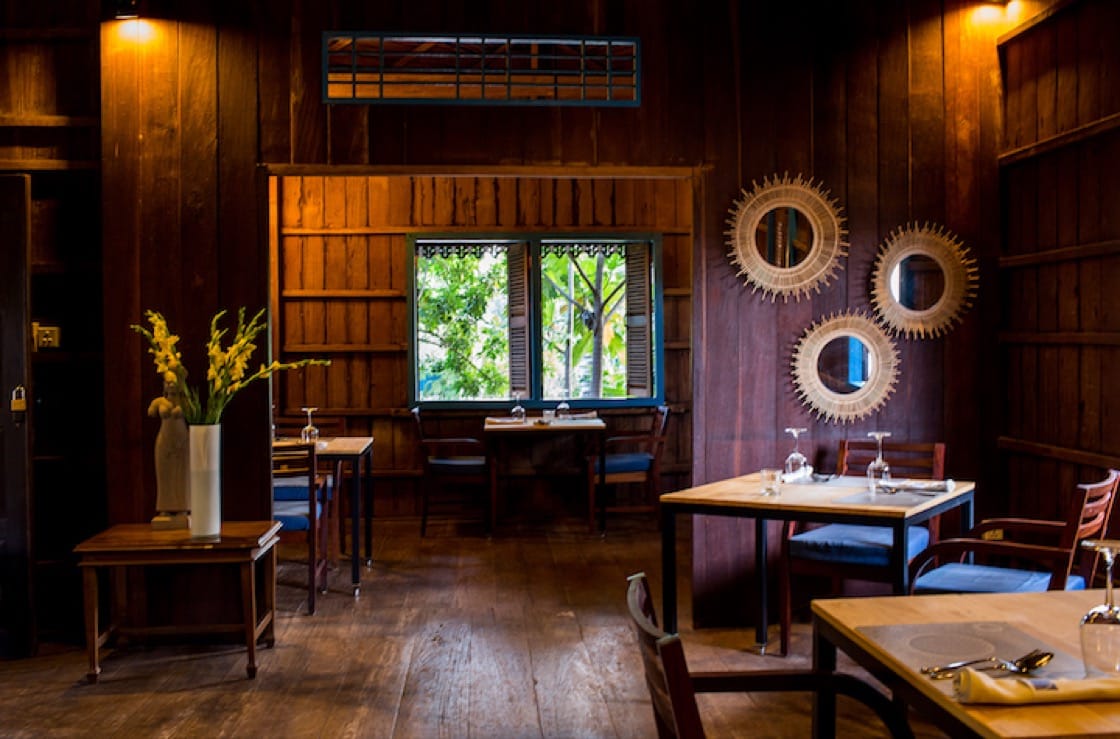
In that time, Rivière found himself enamored by the country’s rich heritage and colorful food culture. He names some of his favorite Cambodian dishes—mi kula, a street food dish of rice noodles with pork, dry shrimp, peanuts and hard-boiled eggs with Burmese roots, and maam chaw, a dish of raw pickled fish and boiled pork eaten with a lot of crudités—with the disclaimer that his favorites change often.

Helmed by Rivière and his wife, Carole Salmon, Cuisine Wat Damnak was born, showcasing innovative menus inspired by the food traditions of Cambodia’s golden age, when each day’s fare was made up of herbs and vegetables from the family garden, and fish and game from the surrounding fields. Cuisine Wat Damnak’s ingredients are almost entirely sourced from nearby farms and foraged from around Siem Reap Province: ambarella and kuy fruits, edible flowers, water lily stems, fish and seafood from the Mekong and Tonle Sap.
We caught up with the chef to discuss all things Cambodia—his favorite local ingredients, how he marries French technique with this style of cuisine and how he’s seen local dining evolve over the years.

Cambodian cuisine is still very rustic and showcases the rurality of this country. People still have a deep connection with their land and ingredients. The food is based on rice, vegetables, fresh water fish and proteins like frog, crab and snails, and their derived products such as all the kinds of fermented fish paste. Soups are very important and meals tend to be balanced on the table and not necessarily in the one dish. For example, you might have a sour soup, a sweet stew and a spicy salad in one meal.
What are some of the unique local ingredients you like to use in your dishes?
I always come back to fresh water fish because it is so unique to the ecosystem and the culture of this country. In January, we had a guest chef from Thailand and we managed to create a seven-course menu only with fresh water fish from the lake—including dessert.
How do you marry French techniques and Cambodian cooking traditions?
In general, all the products and the ways they are combined are local. The French influence only comes in the way we refine the textures and the presentation. A good example is duck. There are two kinds of ducks in Cambodia: the first is farmed for meat are fed with dry fish and dry shrimp so I am pretty sure they taste like seagulls (though to be fair, I have never tried to eat a seagull); the second are ducks farmed for the eggs. They are big, fatty and tasty, but they are so hard that the Cambodians only boil them. We cannot do that because I find that reheating boiled duck tastes awful. So, we confit them slowly and pan fry the meat during service until it’s crunchy. The broth is made with bone, vegetables and spices which are very local, but the duck is incredibly tender and juicy inside and crunchy outside. Cambodian guests tell us that our food does not look like Cambodian food but really tastes like it.

Cambodian food was really just born in recent years. For a long time and even until now, the market has been very cost oriented where “cheap [on] average” is the benchmark, but now you have more and more independent chefs who are taking risks, doing their thing and the result has been great.
What more will it take to truly put Siem Reap on the global dining stage?
Honestly, there is a need for local young talents to travel and be more exposed to what is done around the world or even simply in the region. Cambodian chefs have the energy, they have the talent and the willingness to learn, but the food scene here is as young as they are and they need more sources of emulation.

















